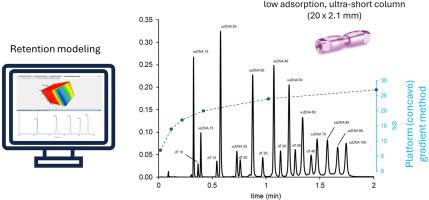使用超短(20 x 2.1 毫米)色谱柱对寡核苷酸进行离子对反相色谱分析。教程
IF 3.2
引用次数: 0
摘要
通过这项工作,我们介绍了在超短色谱柱(20 × 2.1 mm)上使用离子对反相液相色谱(IP-RPLC)分析寡核苷酸(ON,5 至 100 mer)的综合教程。我们探讨了离子配对(IP)剂对ON保留的影响,结果表明,虽然IP剂对绝对保留有显著影响,但对选择性的影响往往微乎其微。我们的发现强调了系统化方法开发(包括软件辅助保留建模)的实用性,可优化梯度陡度和温度,从而优化序列和长度变异的分辨率。我们建议使用低吸附色谱柱硬件,以最大限度地减少非特异性相互作用,这有利于提高方法的稳健性、峰形和回收率(尤其是较短杂质的回收率)。我们的研究结果证实了所谓的超短柱格式的实用性,并通过快速运行时间分离和高通量 ON 分析等实例加以证明。这项研究为开发稳健、可重现、高效的ONs IP-RPLC方法提供了实用指南,对研究新疗法、新测序和诊断试剂的分析人员都有帮助。本文章由计算机程序翻译,如有差异,请以英文原文为准。

Ion-pair reversed-phase chromatography analysis of oligonucleotides using ultra-short (20 x 2.1 mm) columns. Tutorial
With this work, we present a comprehensive tutorial for the analysis of oligonucleotides (ONs, 5 to 100 mer) using ion-pair reversed-phase liquid chromatography (IP-RPLC) on ultra-short columns (20 × 2.1 mm). We explore the impact of ion-pairing (IP) agents on ON retention and demonstrate that while IP agents significantly influence absolute retention, their effect on selectivity is often minimal. Our findings emphasize the utility of systematic method development, including software-assisted retention modeling, to optimize gradient steepness and temperature such that resolution can be optimized for both sequence and length variants. We recommend the use of low-adsorption column hardware to minimize nonspecific interactions, which is to the benefit of improving method robustness, peak shapes and recovery (especially of shortmer impurities). Our results confirm the utility of so-called ultra-short column formats as is demonstrated by way of the example, quick run time separations and high-throughput ON analyses. The study establishes practical guidelines for developing robust, reproducible, and high-efficiency IP-RPLC methods for ONs which will be of assistance to analysts working on new therapeutics and new sequencing and diagnostic reagents alike.
求助全文
通过发布文献求助,成功后即可免费获取论文全文。
去求助
来源期刊

Journal of chromatography open
Analytical Chemistry
CiteScore
2.50
自引率
0.00%
发文量
0
审稿时长
50 days
 求助内容:
求助内容: 应助结果提醒方式:
应助结果提醒方式:


